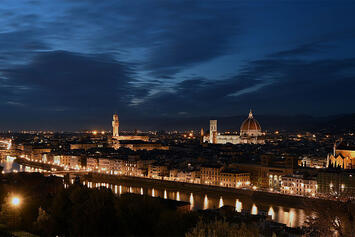
Florence. No city on earth is a more miraculous testament to what entrepreneurs can do, and how hard work and grit can build beauty that endures. Yet as he looks out, over the red roofs and graceful churches of the Tuscan gem, Mattia Guidi sees less a glorious past, and more a stagnating present. “Tourism has a dual effect,” the political scientist at the University of Siena tells me. “Some benefit but there’s not a lot of opportunity.”
It’s a fair point. For if tourism powers the bloc’s otherwise torpid economy, more galleries and restaurants is not what Europe needs. Squeezed by a conservative business culture, and an elephantine welfare state, genuine entrepreneurs increasingly seek exile in the Anglosphere, while the workers that remain wallow in low-paying service jobs. Especially as the shock of Trumpism forces the continent to defend its fading interests, it’s a recipe for economic catastrophe, with the EU expected to encompass just one tenth of global GDP by 2100.
Yet if the Old World needs to reclaim the magic of the Medici, the continent’s redemption will come far from Florence. Rather, Europe’s periphery is leading the way, with places like Portugal and Greece offering sunny business prospects dashed with pleasant weather. Combined with similar dynamism in the former communist states of eastern Europe, it’s increasingly possible to talk of a European Sun Belt. For just like the former Confederacy, once disdained and now booming, the continent’s future will be made on its edges — if, that is, the EU’s reactionary status quo can finally be vanquished.
Europe’s economy is broken. Over the past 15 years, the Eurozone has grown about 6% in dollar terms. The US has jumped 82%. The biggest gap is in tech: of the top 50 tech firms, only three are located in Europe, with the list unsurprisingly dominated by Silicon Valley. Not that Europe’s entrepreneurial deficit is not only in ones and zeros. MIT researcher Andrew McAfee has shown how, over the last 50 years, the US has created “from scratch” companies with market cap of over $10 billion five times faster than the EU. No wonder some observers now quip that Europe is “a museum as a continent and a museum as a stock market”.
Faced with this malaise, and geopolitical upheavals from Kyiv to the White House, it’s little wonder that Europe’s leaders, in Paris and Berlin, are rushing to reindustrialise. That’s clear enough militarily, with the Bundestag promising €500 billion for new tanks and missiles. Yet if the German defence minister claims his countrymen have an “erotic relationship” with weapons — and we agree that bolstered self-sufficiency is necessary given Trump’s rising isolationism — it’s unlikely that Europe can thrive in the 21st century through force-of-arms alone.
Certainly, you shouldn’t count on Brussels, prime mover of the continent’s decline, to reverse the slide to irrelevance. Mario Draghi’s much-ballyhooed response to the current crisis followed the old patterns of green obsessions, social “inclusion” and ever greater conformity with Brussels edicts. Europe’s grandees believe that money fleeing Trumpian chaos will head to a permanent economic shift towards the Old World. But that ignores the fact that Europe is far more dependent on exports than the US, and lacks new industries that can compete with either America or the rising powers of the developing world.
Read the rest of this piece at: UnHerd.
Joel Kotkin is the author of The Coming of Neo-Feudalism: A Warning to the Global Middle Class. He is the Roger Hobbs Presidential Fellow in Urban Futures at Chapman University and and directs the Center for Demographics and Policy there. He is Senior Research Fellow at the Civitas Institute at the University of Texas in Austin. Learn more at joelkotkin.com and follow him on Twitter @joelkotkin.
Photo: Architas, via Wikimedia under CC 4.0 License.












